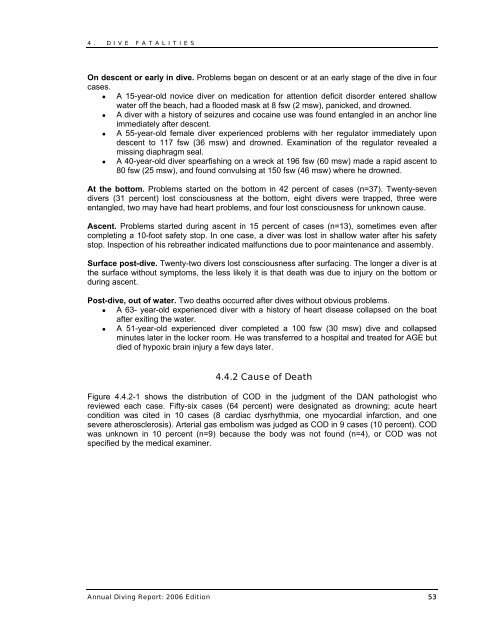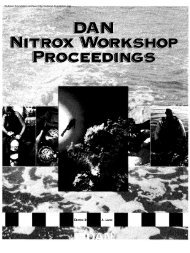Annual Diving Report - Divers Alert Network
Annual Diving Report - Divers Alert Network
Annual Diving Report - Divers Alert Network
Create successful ePaper yourself
Turn your PDF publications into a flip-book with our unique Google optimized e-Paper software.
4. DIVE FATALITIES<br />
On descent or early in dive. Problems began on descent or at an early stage of the dive in four<br />
cases.<br />
● A 15-year-old novice diver on medication for attention deficit disorder entered shallow<br />
water off the beach, had a flooded mask at 8 fsw (2 msw), panicked, and drowned.<br />
● A diver with a history of seizures and cocaine use was found entangled in an anchor line<br />
immediately after descent.<br />
● A 55-year-old female diver experienced problems with her regulator immediately upon<br />
descent to 117 fsw (36 msw) and drowned. Examination of the regulator revealed a<br />
missing diaphragm seal.<br />
● A 40-year-old diver spearfishing on a wreck at 196 fsw (60 msw) made a rapid ascent to<br />
80 fsw (25 msw), and found convulsing at 150 fsw (46 msw) where he drowned.<br />
At the bottom. Problems started on the bottom in 42 percent of cases (n=37). Twenty-seven<br />
divers (31 percent) lost consciousness at the bottom, eight divers were trapped, three were<br />
entangled, two may have had heart problems, and four lost consciousness for unknown cause.<br />
Ascent. Problems started during ascent in 15 percent of cases (n=13), sometimes even after<br />
completing a 10-foot safety stop. In one case, a diver was lost in shallow water after his safety<br />
stop. Inspection of his rebreather indicated malfunctions due to poor maintenance and assembly.<br />
Surface post-dive. Twenty-two divers lost consciousness after surfacing. The longer a diver is at<br />
the surface without symptoms, the less likely it is that death was due to injury on the bottom or<br />
during ascent.<br />
Post-dive, out of water. Two deaths occurred after dives without obvious problems.<br />
● A 63- year-old experienced diver with a history of heart disease collapsed on the boat<br />
after exiting the water.<br />
● A 51-year-old experienced diver completed a 100 fsw (30 msw) dive and collapsed<br />
minutes later in the locker room. He was transferred to a hospital and treated for AGE but<br />
died of hypoxic brain injury a few days later.<br />
4.4.2 Cause of Death<br />
Figure 4.4.2-1 shows the distribution of COD in the judgment of the DAN pathologist who<br />
reviewed each case. Fifty-six cases (64 percent) were designated as drowning; acute heart<br />
condition was cited in 10 cases (8 cardiac dysrhythmia, one myocardial infarction, and one<br />
severe atherosclerosis). Arterial gas embolism was judged as COD in 9 cases (10 percent). COD<br />
was unknown in 10 percent (n=9) because the body was not found (n=4), or COD was not<br />
specified by the medical examiner.<br />
<strong>Annual</strong> <strong>Diving</strong> <strong>Report</strong>: 2006 Edition 53

















